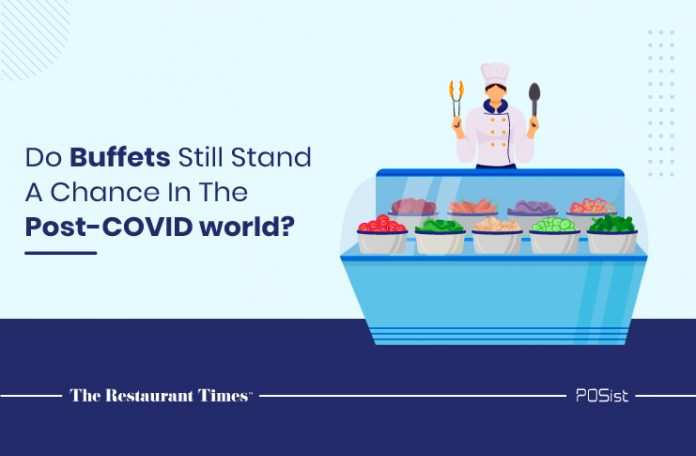The pandemic has shaken the restaurant industry to the core. Dine-in restaurants were shut entirely during the first wave of COVID-19. Online deliveries also ceased during Q2 of the year 2020. However, online deliveries picked up later on, and dine-in restaurants have also started reopening with reduced occupancies. The market segment which has been hit extremely hard and struggling to survive is the buffet model. It is safe to say that the buffet business is gone for good, at least for a significant period.
Why The Buffet Business May Not Survive Post Pandemic
COVID-19 could potentially be the end of the buffet business. Some factors have to be considered before deciding whether or not COVID-19 will lead to the dissolution of the restaurant model. Let us look at them.
- The changes that customers adopt while entering and serving themselves
- How efficiently the safety norms are followed like hand washing, no talk, cough, or sneezing near utensils
- The customer density
- Frequent sanitation
- The physical distance between tables
Let us assume all these factors work in favor of buffet businesses. It is still not completely safe to say that customers won’t be exposed to the contagious virus. Here are the reasons why:
1. Exposed Utensils
Buffets operate on the basis of self-service by the customers. They are free to take their pick from the food options available. However, the dishes and utensils come into contact with many people, which exposes them to risks like dirty or unsanitized hands, sneezing, coughing, etc. Multiple touches pose a high threat of virus contamination.
In a time when everybody is being urged to use masks and gloves, operating buffets is highly risky. Either the staff or the customers are bound to get infected. Only in an ideal scenario can sneeze guards and other virus prevention measures completely contain the spread of COVID-19. Most of the buffet restaurants do not use sneeze guards, and even if they do, there is an issue with the improper installation of sneeze guards.
2. Highly Expensive
Maintaining a buffet business post-pandemic is likely to be a tricky task. One needs to ask whether it is worthwhile continuing to run such a business whose future is uncertain, especially at a time when everyone wants to save their capital and cut costs. With decreased footfall and the closure of a large number of restaurants, it would not be very wise for restaurateurs to continue their buffet business. From repairs and renovations to inventory management, all the costs incurred might shrink what is left of your business after the pandemic.

3. Food Wastage
Food wastage is another primary reason to be considered while explaining the downfall of the buffet business. Due to COVID-19, the Indian economy has faced numerous disruptions in the food supply chain, partly due to the lack of adequate cold storage and transportation facilities.
With fewer customers visiting the buffet restaurants, all the food prepared could be wasted. In the case of perishable items, the situation is even worse. It is improbable that all the dishes will be consumed in a single day. The leftovers are, thus, wasted. Not only is this unethical, but it also works opposite to your profit margins. Wasted food is wasted inventory, which is wasted money.
Many buffet services have had to be shut down because of these reasons. For instance, Taj Hotels did away with their popular and lavish buffets. It is always better to shut down a business that is unviable.
Factors That Still Give Hope To Buffet Business
Not everything is going downhill for the buffet business; there is still hope left. It can be turned around with a few “calculated risks”. This is because of the following reasons:
1. Proper Sanitation
Restaurateurs believe that if sanitation and COVID-19 norms are followed, there is still a possibility for buffet restaurants to regain customer’s confidence. High-touch points should be minimized, and the tables should be appropriately segregated. Only one group should be allowed at the buffet at once. There should be sneeze guards over the food and the utensils to avoid contamination by droplets due to sneezing, coughing, or talking. Furthermore, if need be, the concept of self-service can be changed temporarily, and the staff should be given this duty to minimize contact between customers and the food.
2. Adaption Of Takeaways And Deliveries
To survive the pandemic, buffet restaurants have started offering takeaway and delivery options. Menus and packaging have been changed and made more delivery-focussed. Barbeque Nation, India’s most popular buffet brand, has started providing Barbeque In Box (BIB) to customers at their doorstep. Cloud kitchens are another product of the pandemic. Many of the restaurateurs are transitioning from traditional buffet restaurants to cloud kitchen models.
It is too early to predict whether or not buffet restaurants will be sustainable post-pandemic. While the trends point towards a gradual decline, the future may be quite different. It remains to be seen what the future holds for buffet businesses in India.

















